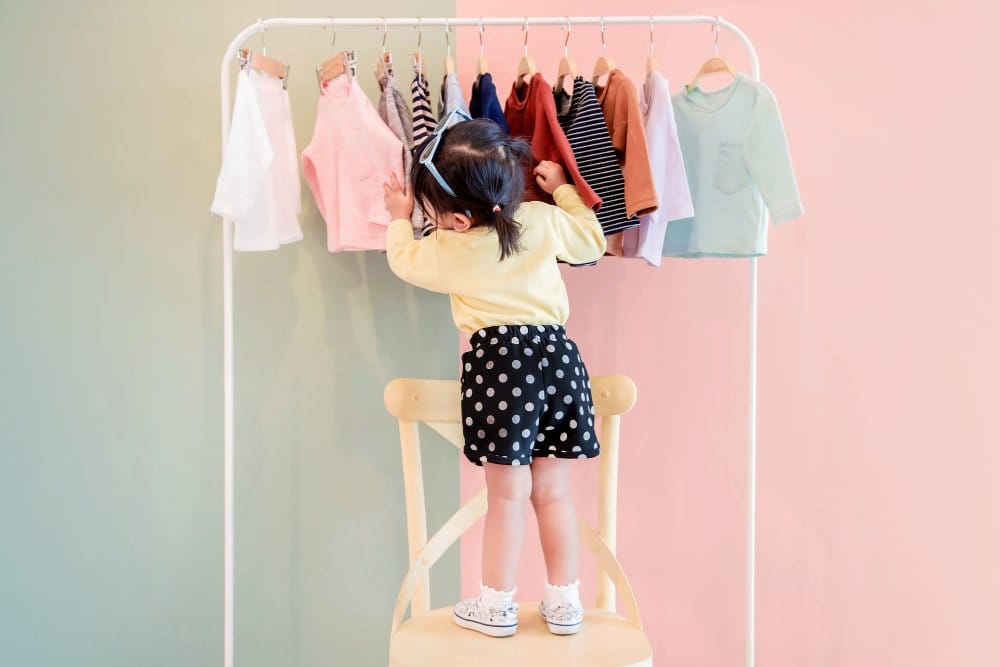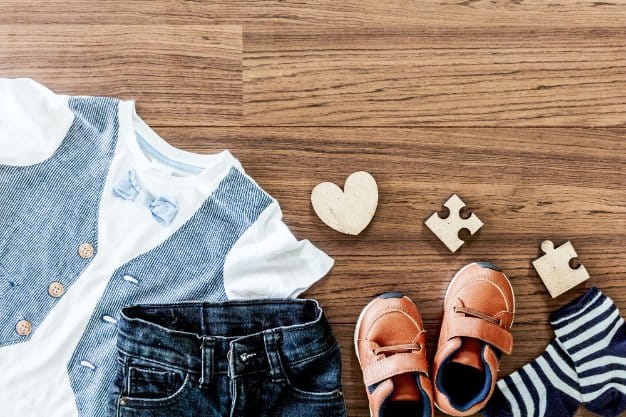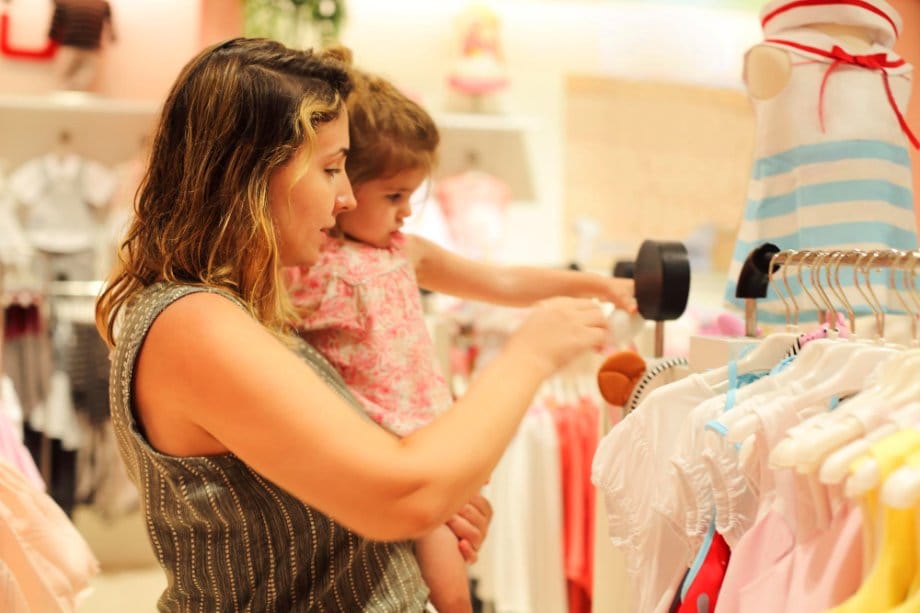Essential clothing guide with quantities, sizes, safety tips, and budget advice for modern parents
A comprehensive guide to building the perfect wardrobe for your growing toddler
As a parent, figuring out exactly what clothes your 2-year-old needs can feel overwhelming. Between rapid growth spurts, daily messes, and constantly changing weather, it seems like you’re always shopping for new clothes or doing laundry. A 2-year-old needs a simple wardrobe of comfortable basics, weather-appropriate outerwear, safe sleepwear, and a few extras for special activities.
The key is focusing on easy-to-wear pieces that let your toddler move, explore, and start making their own clothing choices. Having the right basics on hand, plus appropriate layers for different weather, makes daily routines much smoother and supports your child’s growing independence.
Key Takeaways
- A basic set of 7-10 tops and 5-7 bottoms covers daily needs
- Understanding the difference between 24 months and 2T sizing saves time and money
- Simple, functional clothing works best for growing, active children
- Safety standards for sleepwear are crucial for protecting your child
- Strategic planning keeps costs manageable while ensuring comfort
Table of Contents
- Essential Everyday Clothing
- Understanding 2-Year-Old Sizing
- Seasonal Wardrobe Planning
- Sleepwear and Safety Standards
- Undergarments and Layering
- Specialty and Activity Clothing
- Building Independence Through Clothing
- Sustainable and Organic Options
- Budget-Friendly Wardrobe Management
- Clothing Care and Maintenance
- Common Clothing Challenges
- Frequently Asked Questions
Essential Everyday Clothing for 2-Year-Olds
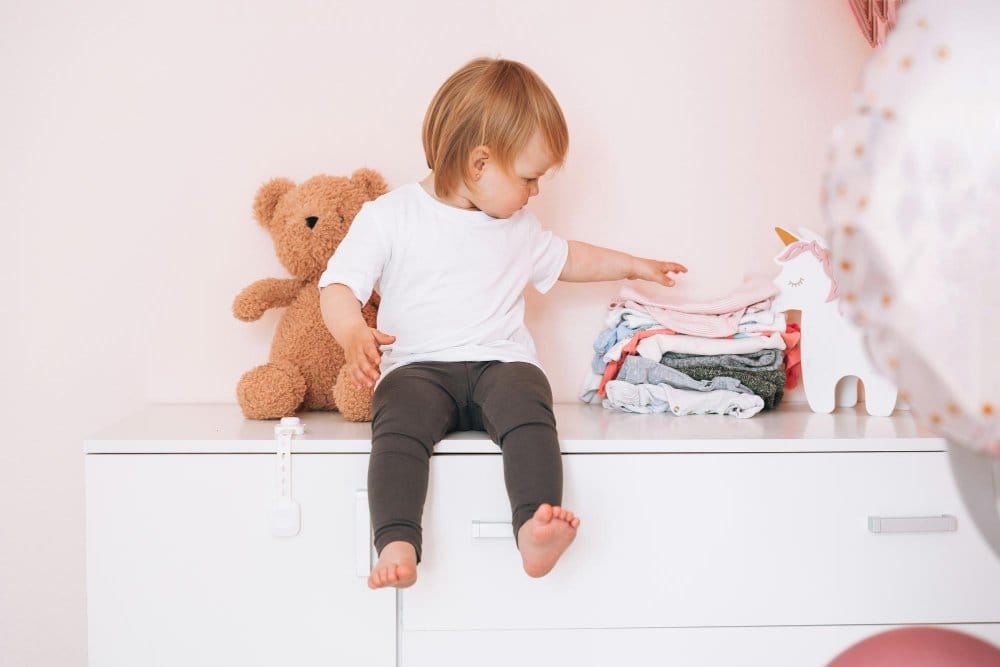
A well-organized collection of essential clothing items for active toddlers
Building a functional wardrobe for your 2-year-old starts with understanding what they actually need for daily life. At this age, children need comfortable, easy-to-wear pieces that support their active lifestyle and growing independence.
Bottom Line: A 2-year-old needs approximately 7-10 tops, 5-7 bottoms, 3-5 pajama sets, 2-3 outerwear pieces, and adequate undergarments for a functional wardrobe that lasts between laundry days.
How Many Outfits for a 2-Year-Old?
The number of outfits your toddler needs depends on your laundry frequency and lifestyle:
- Daily laundry: 3-4 complete outfits plus backup
- Every other day: 5-6 complete outfits
- Twice weekly: 7-8 complete outfits
- Weekly laundry: 10-12 complete outfits
Core Clothing Quantities
| Item Type | Recommended Quantity | Notes |
|---|---|---|
| T-shirts (short sleeve) | 5-7 | Basic wardrobe foundation |
| Long-sleeve shirts | 3-5 | Layering and cooler weather |
| Pants/Leggings | 5-7 | Focus on elastic waists |
| Shorts | 3-4 | Summer and warm weather |
| Dresses (if applicable) | 2-3 | Easy one-piece options |
| Pajama sets | 3-5 | Must meet safety standards |
| Underwear/Training pants | 7-10 | More needed during potty training |
| Socks | 10-12 pairs | Easy to lose, buy extras |
| Shoes | 2-3 pairs | Everyday, dress, and outdoor |
Tops and Bottoms Essentials
For tops, focus on a mix of short-sleeved and long-sleeved options. These form the foundation of your toddler’s wardrobe and should be made from soft, breathable cotton or cotton blends that wash easily and feel comfortable against sensitive skin.
When choosing pants, prioritize pull-on styles with elastic waistbands. These make diaper changes easier and help toddlers learn to dress themselves. Training pants become especially important if your child is beginning potty training.
Pro Tip: Buy basics in neutral colors like navy, gray, and white. They hide stains better and mix and match easily, giving you more outfit combinations with fewer pieces.
Comfortable Clothing Choices
Comfort should be your top priority when selecting clothes for your 2-year-old. Look for soft, stretchy fabrics that move with your child’s active lifestyle.
Best Fabric Choices
- 100% cotton – breathable and soft
- Cotton blends – durability with comfort
- Bamboo – naturally antimicrobial
- Merino wool – temperature regulating
Features to Avoid
- Scratchy tags or seams
- Tight elastic that leaves marks
- Complex buttons or zippers
- Non-breathable synthetic materials
Choose clothes your child enjoys wearing. This makes daily routines much smoother and reduces clothing battles. Simple features like tagless labels, flat seams, and soft waistbands can make a huge difference in your toddler’s comfort level.
Weather-Appropriate Outfit Planning
Plan outfits based on your local climate and season. Layering is key because weather can change throughout the day, and you can easily add or remove items as needed.
Spring/Fall
Light layers, cardigans, light jackets
Summer
Lightweight cotton, sun protection, breathable fabrics
Winter
Warm layers, insulated outerwear, accessories
Rainy Days
Waterproof jacket, boots, quick-dry materials
Understanding 2-Year-Old Sizing: The Complete Guide
One of the most confusing aspects of shopping for 2-year-old clothes is understanding sizing, especially the difference between 24 months and 2T. This isn’t just marketing confusion – there are real, practical differences that affect fit and functionality.
Sizing Alert
24 months and 2T are NOT the same size, despite both being intended for 2-year-olds. Understanding the difference helps ensure proper fit and comfort for your child.
Are 24 Months and 2T the Same?
The short answer is no. While both sizes are designed for children around 2 years old, they serve different developmental stages and body types. Understanding these differences will save you time, money, and frustration when shopping.
24 Months vs 2T: The Key Differences
| Aspect | 24 Months | 2T |
|---|---|---|
| Target Age | 18-24 months | 2-3 years |
| Body Shape | Rounder, baby-like proportions | Longer, more toddler-like |
| Diaper Accommodation | Extra room for diapers | Slimmer fit, assumes potty training |
| Length | Shorter overall | Longer arms and legs |
| Design Features | Snap closures, easier changes | More grown-up features |
| Store Department | Baby section | Toddler/children’s section |
What Does the “T” Stand for in 2T?
The “T” in sizing like 2T, 3T, and 4T stands for “Toddler.” This sizing system acknowledges that toddlers have different body proportions than babies. Toddler sizes account for:
- Longer limbs relative to torso
- Slimmer waist and hip area
- More upright posture
- Different mobility needs
- Developmental milestones like potty training
What Size of Clothes Should a 2-Year-Old Wear?
Most 2-year-olds wear either 24 months or 2T, but the right choice depends on your child’s individual development and body type. Here’s how to decide:
Choosing the Right Size for Your 2-Year-Old
Consider these factors:
- Current development stage: Still in diapers? Choose 24 months. Potty training or trained? Consider 2T.
- Body type: Chubby toddler with baby proportions? 24 months may fit better.
- Height: Tall for age? 2T provides more length in arms and legs.
- Brand variation: Always check individual brand size charts as measurements vary.
- Activity level: Very active children may need the extra room in 2T sizing.
Need help comparing sizes? Use our toddler size comparison tool to find the perfect fit for your child across different brands.
Should I Buy 2T or 3T for a 2-Year-Old?
This depends on your child’s size, growth rate, and when you’re shopping:
- Average size child: Start with 2T for current wear
- Large for age: Consider 3T, especially for next season purchases
- Small for age: 24 months might still fit well
- Rapid growth: Buy some 3T pieces for longevity
- End-of-season shopping: Size up for next year
Shopping Tip: When buying for the next season, go one size up. A child wearing 2T in summer will likely need 3T for the following winter.
What Age Usually Wears 2T?
While 2T is designed for 2-3 year olds, the actual age range can vary:
- Early 2T wearers: Large 18-24 month olds
- Typical 2T age: 2-3 years old
- Late 2T wearers: Small 3-4 year olds
Remember, children grow at different rates. Focus on your individual child’s measurements rather than comparing to age norms.
Weight and Size Guidelines
How Much Should a 2-Year-Old Weigh?
According to pediatric growth charts, healthy 2-year-olds typically weigh:
- Girls: 22-32 pounds (average: 27 pounds)
- Boys: 24-34 pounds (average: 28 pounds)
What Size is Normal for a 2-Year-Old?
Normal height ranges for 2-year-olds:
- Girls: 31-37 inches (average: 34 inches)
- Boys: 32-37 inches (average: 35 inches)
Growth Tracking
These are general guidelines. Healthy children can fall outside these ranges. Your pediatrician is the best resource for assessing if your child’s growth is on track for their individual growth curve.
Seasonal Wardrobe Considerations

Weather-appropriate clothing options for every season and climate
Planning your 2-year-old’s wardrobe by season ensures they’re comfortable year-round while avoiding unnecessary purchases. Weather-appropriate clothing keeps your toddler comfortable and safe during outdoor play.
Warm Weather Outfits
In warmer months, focus on light, breathable clothing. Choose short-sleeved shirts, cotton dresses, and shorts made from natural fibers that help keep your child cool.
Summer Clothing Checklist
- 5-7 short-sleeve t-shirts
- 3-4 pairs of shorts
- 2-3 lightweight dresses (if applicable)
- 1-2 sun hats with wide brims
- 1 light jacket for air conditioning
- 1 raincoat for unexpected showers
- 2-3 pairs of sandals (closed-toe preferred for safety)
- 1-2 pairs of tights for cooler summer days
- Swimwear for water play
Want a complete seasonal checklist? Download our comprehensive toddler seasonal wardrobe checklist to ensure you never miss essential items.
Summer Safety Tip: Choose UPF-rated clothing for extended sun exposure. Even in warm weather, closed-toe shoes are safer for playground activities to protect little feet from injuries.
Cold Weather Clothing
Cold weather dressing requires strategic layering. You want to keep your toddler warm while still allowing them to move freely and dress independently when possible.
Winter Clothing Checklist
- 5-7 long-sleeve shirts for layering
- 2-3 warm sweaters or hoodies
- 1-2 vests for easy layering
- 1 warm, waterproof winter coat
- 2-3 pairs of warm pants or thick leggings
- 2-3 pairs of thermal underwear or warm tights
- 2-3 warm hats that cover ears
- 2-3 pairs of mittens (buy extras – they get lost!)
- 1 pair of warm, waterproof boots
- 1 lined raincoat for wet, chilly days
Planning ahead for all seasons? Check out our seasonal toddler clothing shopping timeline to know exactly when to shop for next season’s clothes.
How to Dress a Toddler in 30-Degree Weather
Cold weather dressing requires careful layering to keep your toddler warm without overheating. Here’s the proven layering system:
Car Seat Safety in Cold Weather
Never put your child in a car seat while wearing a bulky coat. The padding can compress in an accident, leaving the harness too loose. Remove the coat, buckle your child in, then put the coat on backwards or use a blanket over the harness.
For extremely cold weather (below 20°F), add extra layers and limit outdoor time. Watch for signs of being too cold (blue lips, shivering) or too warm (sweating, fussiness).
Sleepwear and Pajamas: Safety First
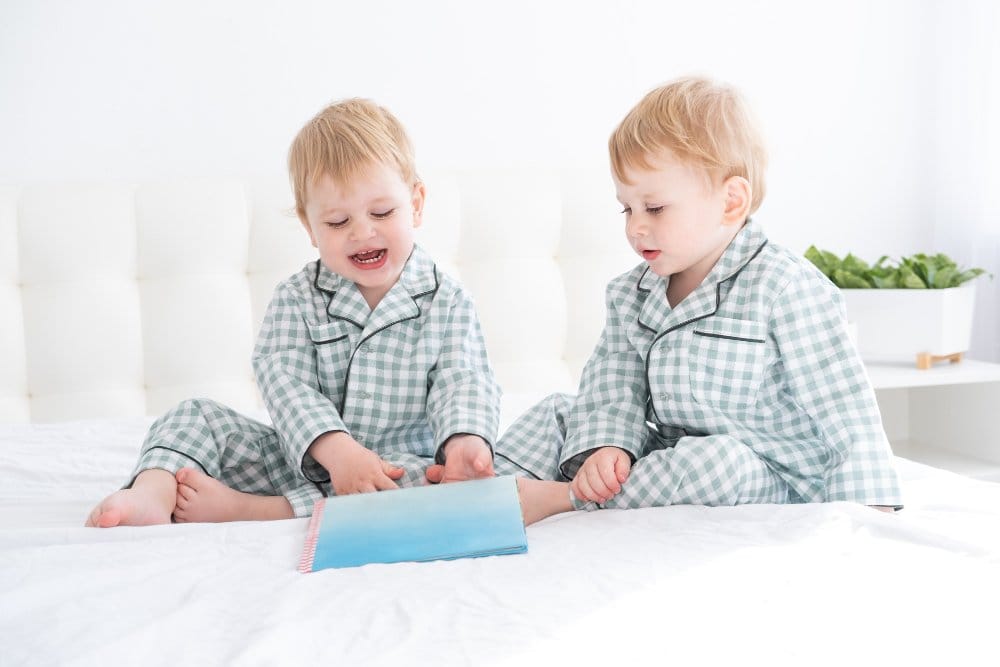
Safe sleepwear options that meet federal safety standards for toddlers
Choosing safe sleepwear for your 2-year-old involves more than just comfort. Federal safety regulations exist to protect children from burn injuries, and understanding these rules helps you make informed decisions about flame-resistant clothing.
Critical Safety Information
Children’s sleepwear sizes 9 months through 14 must either be flame-resistant or fit snugly according to federal safety standards established by the Consumer Product Safety Commission.
Understanding Sleepwear Safety Standards
The Consumer Product Safety Commission (CPSC) requires that children’s pajamas meet specific flammability standards. These regulations protect children from serious burn injuries if they come into contact with open flames from candles, matches, stoves, or fireplaces.
Two Ways Pajamas Can Meet Safety Standards:
Flame-Resistant Pajamas
- Treated with flame-retardant chemicals OR made from naturally flame-resistant materials
- Self-extinguish if ignited
- Can be loose-fitting
- Often made from synthetic materials or treated cotton
- Must pass specific burn tests
Snug-Fitting Pajamas
- No chemical treatments needed
- Must fit close to the body
- Usually made from cotton
- Require yellow warning tag
- Safety through fit, not chemicals
Identifying Safe Pajamas
Look for the Yellow Tag: Snug-fitting cotton pajamas must have a yellow hang tag that reads: “For children’s safety, garment should fit snugly. This garment is not flame-resistant. Loose-fitting garment is more likely to catch fire.”
Types of Sleepwear for 2-Year-Olds
Most 2-year-olds can wear either one-piece or two-piece pajamas, depending on your preference and their needs:
One-Piece Sleepers
- Good for children who remove pajamas at night
- Keep the child covered all night
- Usually have zippers or snaps for easy changes
- Cover the whole body for warmth
Two-Piece Pajama Sets
- Easier for potty trips and diaper changes
- More grown-up feeling for toddlers
- Allow temperature regulation
- Easier for children learning to dress themselves
Do 2-Year-Olds Wear Onesies?
While most 2-year-olds transition to two-piece pajamas, onesies can still be appropriate for:
- Children who remove their pajamas at night
- Very active sleepers who get tangled in loose clothing
- Transitioning from crib to toddler bed
- Cold climates where extra coverage helps maintain warmth
- Children with special needs who benefit from the security
Chemical-Free Pajama Options
Many parents prefer to avoid flame-retardant chemicals. Safe alternatives include:
- Snug-fitting organic cotton: Look for GOTS-certified options
- Wool pajamas: Naturally flame-resistant without chemical treatments
- Tight-fitting modal or bamboo: Natural fibers with inherent safety benefits
- Hemp blends: Naturally less flammable than conventional cotton
Choosing Safe and Comfortable Pajamas
When selecting pajamas for your 2-year-old, prioritize safety without sacrificing comfort:
- Check the fit: Snug-fitting pajamas should be close to the body but not restrictive
- Avoid loose elements: No loose ribbons, hoods, or decorative elements that could pose choking risks
- Choose soft fabrics: Cotton and cotton blends are gentle on sensitive skin
- Consider the season: Lightweight for summer, warmer options for winter
- Easy changes: Simple designs that allow for quick diaper or pajama changes
Sleep Safety Reminder
Beyond clothing, ensure your toddler’s sleep environment is safe. Remove loose bedding, toys, and other items that could pose suffocation risks, especially if transitioning from a crib to a toddler bed.
Undergarments and Layering
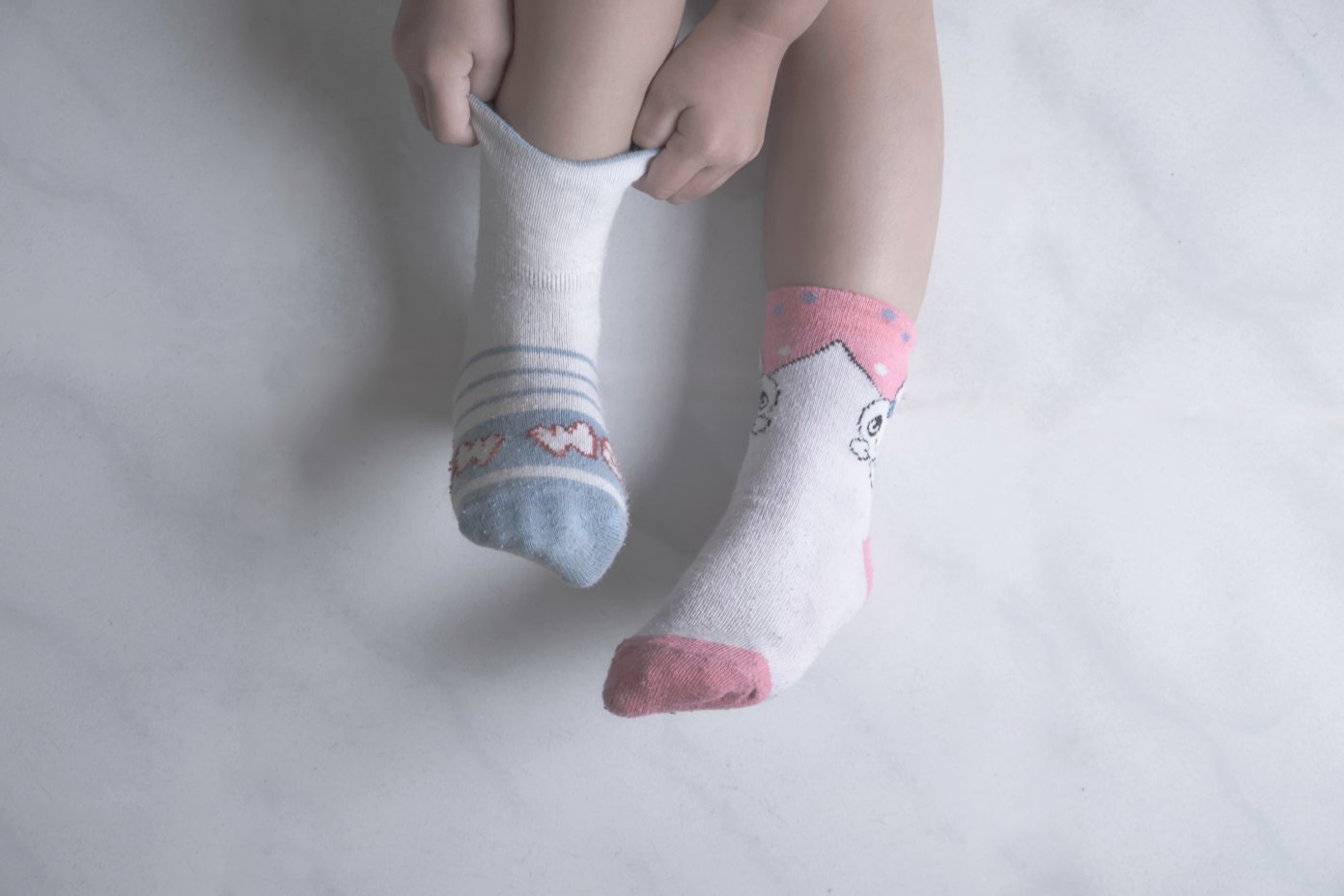
Essential undergarments and layering pieces for toddler comfort and temperature control
Proper undergarments and layering strategies help keep your 2-year-old comfortable throughout changing weather and activities. The right base layers also support sensitive skin health and temperature regulation.
Selecting Undergarments
When choosing undergarments for your 2-year-old, prioritize comfort and functionality. Look for soft materials like cotton that are gentle on sensitive skin and help wick moisture away from the body.
Essential Undergarments for 2-Year-Olds:
- Undershirts or vests: Add warmth in cooler months and provide a soft layer under scratchy fabrics
- Training pants or underwear: Essential if potty training has begun
- Socks: Should fit snugly but not tight; buy extras as they’re easily lost
- Tights or leggings: Useful under dresses and for extra warmth
Even basic undergarments like undershirts can be important, especially in variable weather. They provide an extra layer of warmth and create a barrier between your child’s skin and outer clothing.
Layering for Comfort and Flexibility
Effective layering helps keep your 2-year-old comfortable as temperatures change throughout the day. A good rule of thumb is to dress your child in one more layer than you would wear yourself.
Layering Strategy: Start with a fitted base layer, add an insulating middle layer if needed, and finish with an outer layer that can be easily removed. This system allows you to adjust your child’s comfort level throughout the day.
Effective Layering Pieces:
- Lightweight undershirts: Comfortable base layer
- Long-sleeve shirts: Versatile middle layer
- Cardigans or zip-up hoodies: Easy to remove outer layer
- Vests: Add warmth to core without bulk in arms
Layered clothing should be easy to remove or add throughout the day. Choose pieces with zippers, snaps, or stretchy materials that allow for quick adjustments. Avoid bulky items that restrict movement or cause overheating.
Keep spare layers handy for changes in weather or after messy play. Having an extra sweatshirt in the car or diaper bag can save the day when unexpected weather hits.
Specialty and Activity Clothing
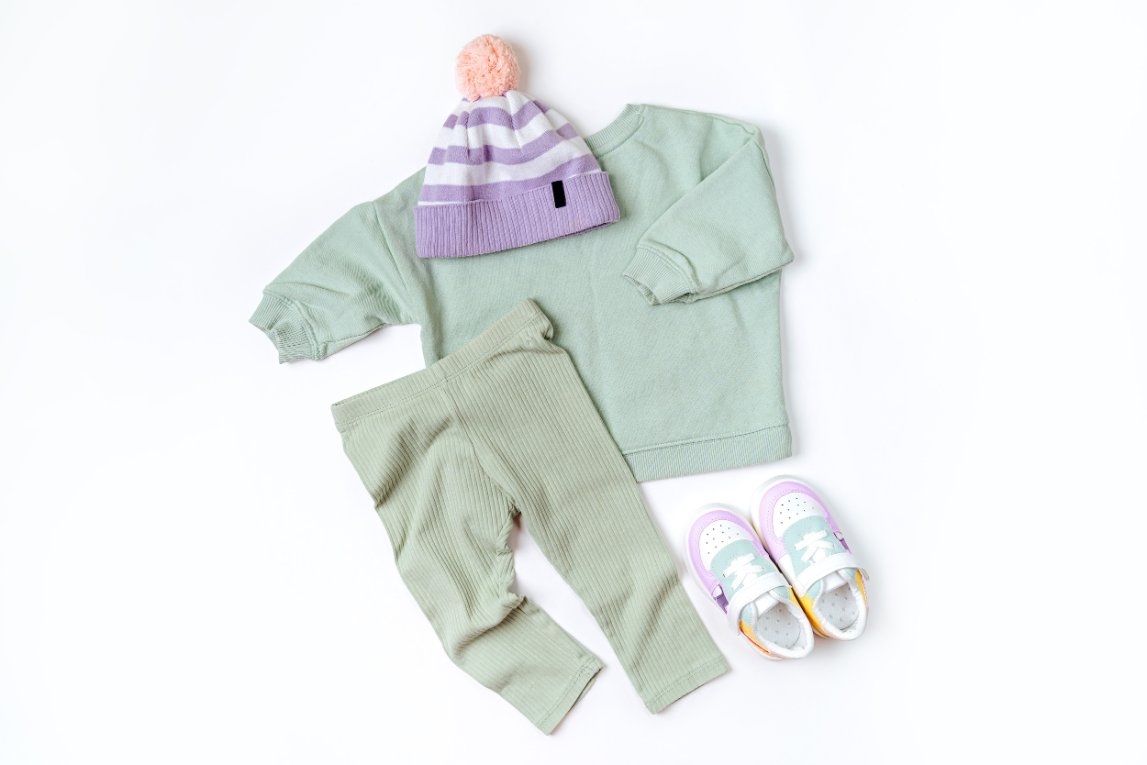
Specialized clothing for water play, outdoor adventures, and special occasions
Certain activities and weather conditions require specialized clothing to keep your 2-year-old safe, comfortable, and clean. Having the right gear for specific situations makes outings more enjoyable for everyone.
Swimsuits and Water Play Attire
When your child plays in water or goes swimming, proper swimwear protects their skin while allowing for safe, comfortable movement.
Choosing Safe Swimwear:
- Proper fit: Snug enough to stay on but not restrictive
- Sun protection: Rash guards shield arms and back from UV rays
- Quick-drying materials: Prevent prolonged wetness and chafing
- Secure construction: Well-sewn seams and secure straps
- Bright colors: Easier to spot your child in crowded areas
For water play outside, include a wide-brimmed hat and water shoes to protect feet from hot pavement and rough surfaces. Always have dry clothes ready for after water activities.
Water Safety
Never rely on clothing for water safety. Always provide proper supervision and appropriate flotation devices designed for your child’s age and swimming ability.
Rain Gear and Outdoor Wear
Playing outside in rain or wet weather requires specific gear to keep your child dry and comfortable while allowing for active play.
Essential Rain Gear:
- Waterproof raincoat: Choose one with a hood and easy-to-use closures
- Waterproof pants or overalls: Protect legs from mud and water
- Rain boots: Non-slip soles and easy-on design
- Puddle suits: One-piece protection for very wet or muddy conditions
Look for rain gear with reflective elements for visibility and avoid overly complex fastenings that frustrate toddlers. After outdoor play, always change your child into dry clothes to prevent chills.
Special Occasion Clothing
While everyday comfort should be the priority, you’ll occasionally need dressier options for special events, family photos, or holidays.
Building a Special Occasion Wardrobe:
- One dressy outfit: For weddings, holidays, or formal events
- Nice shoes: Comfortable but presentable footwear
- Cardigan or blazer: Elevates basic outfits
- Accessories: Bow ties, hair accessories, or nice belt
Special Occasion Tip: Even dressy clothes should be comfortable and allow for normal toddler movement. Avoid anything that requires your child to “be careful” or restricts their natural behavior.
Encouraging Independence Through Clothing Choices
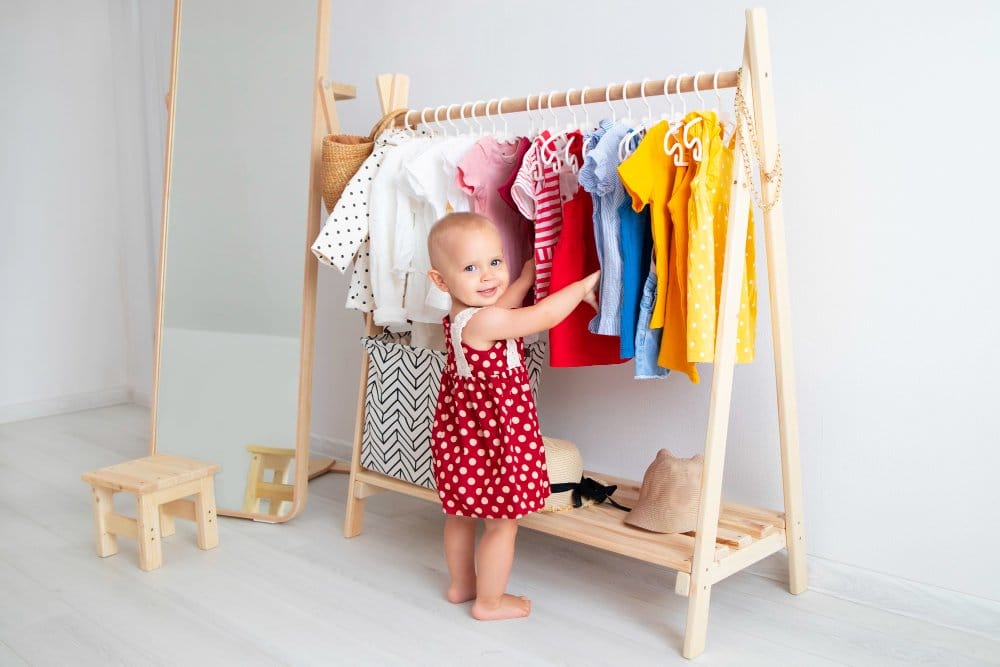
Supporting toddler independence with age-appropriate clothing choices and dressing skills development
Two-year-olds are developing crucial self-help skills, and clothing choices can significantly support this development. Allowing toddlers to participate in clothing selection builds confidence and independence while reducing daily battles.
What Are the Dressing Skills of a 2-Year-Old?
Understanding what your 2-year-old can reasonably accomplish helps set appropriate expectations and choose supportive clothing:
Typical 2-Year-Old Dressing Abilities:
- Put on and remove shoes (without laces)
- Put arms through sleeves with minimal help
- Pull up simple pants with elastic waists
- Remove socks and simple shirts
- Identify front and back of clothing (with visual cues)
- Express clear preferences for certain clothes
- Help with putting on coats
- Beginning to zip large zippers
How to Dress a 2-Year-Old for Success
Supporting your toddler’s independence while ensuring they’re appropriately dressed requires strategic clothing choices and patience.
Clothing Features That Support Independent Dressing:
- Elastic waistbands: Much easier than buttons, snaps, or belts
- Wide neck openings: Easier to get over the head without getting stuck
- Velcro shoes: More manageable than laces or complex buckles
- Large, easy-grip zippers: Toddler-sized hands can manage these better
- Front/back indicators: Tags, pictures, or designs that show correct orientation
- Step-in styles: Easier than pull-over designs
Should You Change Clothes in Front of a 2-Year-Old Toddler?
This personal family decision involves several considerations:
Factors to Consider:
- Body awareness development: Toddlers are beginning to understand privacy concepts
- Modeling appropriate behavior: Children learn social norms by observing
- Family values and comfort levels: Each family has different boundaries
- Teaching opportunities: Chances to discuss body privacy and respect
- Cultural considerations: Different cultures have varying norms
Many child development experts suggest beginning to model privacy around age 2-3 as children become more aware of bodies and differences. This can be done gradually and age-appropriately.
The 3-3-3 Rule for Clothes
The 3-3-3 rule is a minimalist approach to clothing that some families find helpful:
For Toddlers, This Translates To:
- 3 clean shirts ready to wear
- 3 clean pairs of pants/shorts ready
- 3 backup complete outfits for emergencies
This system works well for families who do laundry frequently and prefer minimal wardrobes. However, it may not be practical for all families, especially those with limited laundry access or very active toddlers who go through multiple outfit changes daily.
Promoting Self-Dressing Success
To encourage your child’s dressing independence while maintaining daily routines:
- Set up for success: Organize clothes in accessible drawers or baskets
- Offer guided choices: “Would you like the red shirt or the blue shirt?”
- Practice during calm times: Not when you’re rushed
- Break tasks into steps: Focus on one skill at a time
- Celebrate progress: Acknowledge effort and improvement
- Be patient with backwards clothing: It’s part of learning
Independence Tip: Lay out clothes the night before and allow extra time in the morning. A relaxed pace supports learning better than rushing through dressing routines.
Sustainable and Organic Clothing Options
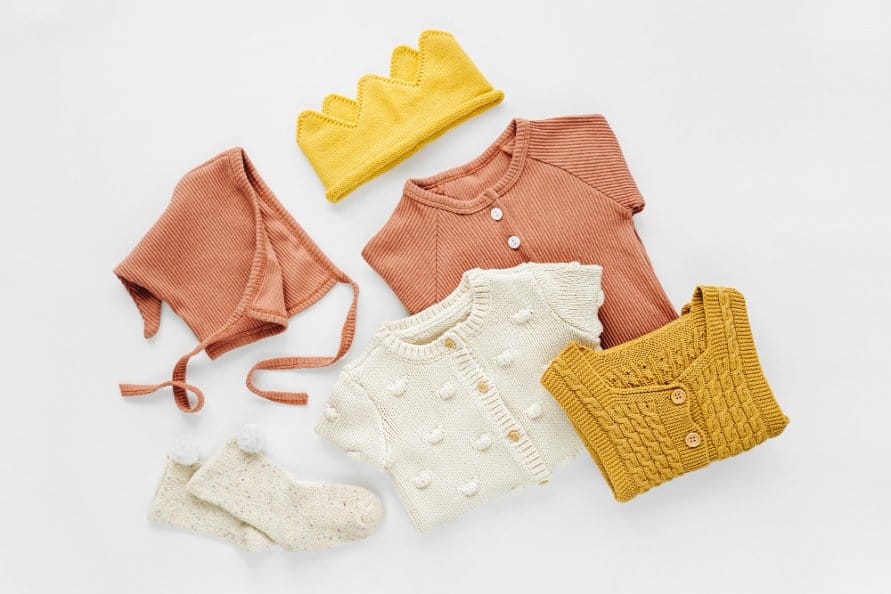
Eco-friendly and organic clothing options that prioritize both child health and environmental responsibility
Many parents are choosing organic and sustainable clothing options for their children’s health and environmental benefits. These brands prioritize safety, durability, and ethical manufacturing practices.
Why Choose Organic Clothing for Toddlers?
Benefits of Organic Clothing:
- Reduced chemical exposure: No pesticides or harsh processing chemicals
- Softer fabrics: Gentler on sensitive toddler skin
- Better durability: Often lasts longer than conventional alternatives
- Environmental protection: Supports sustainable farming practices
- Hypoallergenic properties: Less likely to cause skin reactions
Top Sustainable Brands for 2-Year-Olds
Hanna Andersson
GOTS-certified organic cotton with bold, kid-friendly designs. Known for excellent durability and their “Hanna-Me-Downs” pre-loved program.
Price range: $-$$
Specialty: Pajamas and everyday basics
Kate Quinn
Luxury organic cotton and bamboo at accessible prices. Beautiful prints with incredibly soft fabrics.
Price range: $
Specialty: Coordinated sets and rompers
Colored Organics
GOTS-certified basics in neutral, earthy colors. Perfect for creating mix-and-match wardrobes.
Price range: $
Specialty: Neutral basics and layering pieces
L’ovedbaby
Organic cotton basics with focus on comfort and safety. Excellent for children with sensitive skin.
Price range: $-$
Specialty: Everyday essentials and sleepwear
What to Look for in Sustainable Clothing
When shopping for sustainable toddler clothing, look for these certifications and features:
Important Certifications:
- GOTS (Global Organic Textile Standard): Ensures organic content and ethical production
- OEKO-TEX Standard 100: Tests for harmful substances in textiles
- Cradle to Cradle Certified: Evaluates entire product lifecycle
- Fair Trade Certified: Ensures ethical treatment of workers
Sustainable Features to Prioritize:
- Natural dyes: Low-impact or plant-based coloring processes
- Durable construction: Quality that lasts through multiple children
- Minimal packaging: Reduced environmental waste
- Take-back programs: Brands that accept clothes for recycling
Budget Reality: Sustainable clothing often costs more upfront but provides better value through durability, safety, and higher resale value. Consider cost-per-wear rather than initial price.
Affordable Sustainable Options
Sustainable doesn’t have to mean expensive. Consider these budget-friendly approaches:
- Secondhand shopping: High-quality brands at reduced prices
- Clothing swaps: Trade with other parents
- End-of-season sales: Buy organic brands at discount
- Investment pieces: Buy sustainable basics, conventional trendy items
- Check discount retailers: Sometimes carry sustainable brands at lower prices
Managing Clothing Needs and Budgets
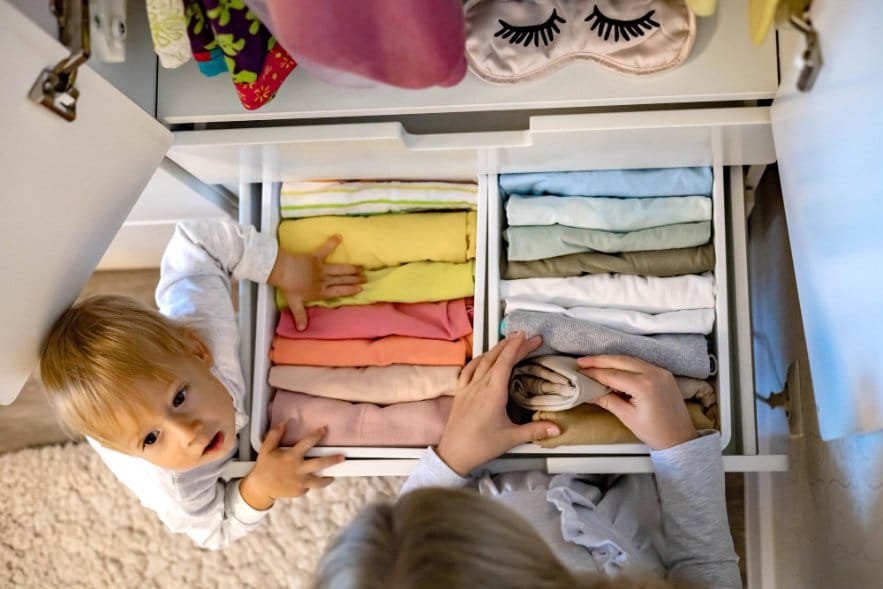
Smart budget management and wardrobe planning strategies for growing toddlers
Dressing a rapidly growing toddler doesn’t have to break the bank. Smart shopping strategies and wardrobe planning can keep costs manageable while ensuring your child has everything they need.
Planning a Budget-Friendly Wardrobe
Start by determining how many clothes your child actually needs based on your laundry schedule and lifestyle. Most toddlers can get by with much less than you might think.
Basic Wardrobe Formula:
| Laundry Frequency | Tops Needed | Bottoms Needed | Pajamas Needed |
|---|---|---|---|
| Daily | 4-5 | 3-4 | 2-3 |
| Every other day | 6-7 | 4-5 | 3-4 |
| Twice weekly | 8-10 | 6-7 | 4-5 |
| Weekly | 10-12 | 7-8 | 5-6 |
Smart Shopping Strategies
Money-Saving Shopping Tips
- Shop end-of-season sales for next year (buy 3T in winter for next summer)
- Focus on neutral colors that mix and match easily
- Invest in quality for high-wear items (coats, shoes, pajamas)
- Buy basics at discount stores, splurge on special pieces
- Check consignment shops and online resale platforms
- Organize clothing swaps with other parents
- Buy slightly larger sizes for longer wear (within reason)
- Choose versatile pieces that work for multiple occasions
Timing your purchases right? Our seasonal shopping timeline shows you the best times to buy each type of clothing for maximum savings.
Using Hand-Me-Downs Effectively
Hand-me-downs can significantly reduce clothing costs when managed properly. Here’s how to make the most of them:
Hand-Me-Down Best Practices:
- Inspect carefully: Check for wear, stains, missing buttons, and safety issues
- Organize by size: Store future sizes in labeled containers by season
- Wash before storing: Clean clothes store better and are ready to use
- Keep inventory lists: Know what you have to avoid duplicate purchases
- Pass it forward: Donate or sell what your child outgrows
- Fill gaps strategically: Buy new items only for what’s missing
Hand-Me-Down Tip: Accept hand-me-downs graciously even if some items aren’t your style. You can always donate what doesn’t work and keep the useful pieces.
When to Invest vs. When to Save
Strategic spending helps you get the most value from your clothing budget:
| Invest in Quality | Save Money On | Reasoning |
|---|---|---|
| Winter coats and outerwear | Basic t-shirts and play clothes | Outerwear gets heavy use; basics are replaced frequently |
| Everyday shoes | Trendy or character clothing | Good shoes support growing feet; trends change quickly |
| Pajamas | Special occasion outfits | PJs worn 12+ hours daily; fancy clothes worn rarely |
| Underwear and socks | Swimwear | Foundation pieces affect daily comfort; swimwear outgrown quickly |
Growth and Transition Planning
Planning ahead for growth spurts and seasonal transitions helps avoid emergency shopping trips:
Size-Up Timing Strategies:
- Buy next size basics: Have a few items in the next size ready
- Seasonal planning: Buy winter clothes in larger sizes for next year
- Growth spurt preparation: Keep one complete outfit in the next size
- Monitor fit regularly: Check monthly for sizing changes
Budget Reality Check
Remember that children’s clothing needs are temporary. Avoid overspending on items they’ll quickly outgrow. Focus your budget on safety, comfort, and practicality rather than having the latest trends.
Clothing Care and Maintenance
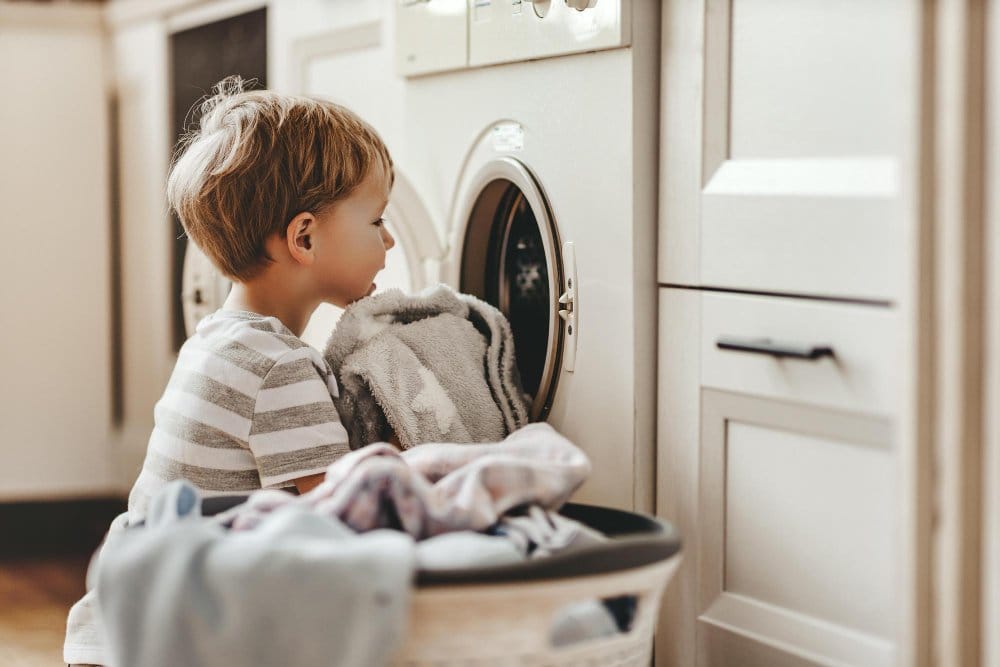
Essential care and maintenance practices to extend the life of toddler clothing
Proper care extends the life of your 2-year-old’s clothes, saving money and keeping garments looking their best. With the right approach to washing and storing toddler clothes, you can maximize your clothing investment.
Washing and Laundry Tips
Toddler clothes face unique challenges – from food stains to playground dirt. Here’s how to keep them clean and in good condition:
Essential Laundry Guidelines:
- Sort by color and fabric type: Prevent color bleeding and fabric damage
- Use gentle, hypoallergenic detergent: Safe for sensitive skin
- Pre-treat stains immediately: The sooner you treat stains, the better the results
- Wash in cold water: Prevents shrinking and preserves colors
- Use delicate cycle for special items: Protects decorations and delicate fabrics
- Air dry when possible: Heat can damage fibers and cause shrinking
Stain Removal for Common Toddler Messes
Quick action and the right techniques can save clothes from permanent staining:
| Stain Type | Treatment Method | Tips |
|---|---|---|
| Food stains | Rinse with cold water, then enzyme detergent | Never use hot water on protein stains |
| Grass stains | Rub with alcohol or enzyme detergent | Work from outside of stain inward |
| Paint/markers | Check if washable; use appropriate solvent | Act quickly before stain sets |
| Mud | Let dry completely, brush off, then wash | Never rub wet mud – it spreads the stain |
| Bodily fluids | Rinse immediately, enzyme detergent | Use cold water to prevent setting |
Stain Prevention: Keep a stain removal pen in your diaper bag for immediate treatment. The faster you act, the better your chances of complete stain removal.
Proper Storage and Organization
Good organization makes getting dressed easier and helps preserve clothes for longer wear:
Storage Best Practices:
- Organize by size and season: Keep current sizes accessible
- Use cedar or lavender: Natural moth deterrents for stored clothes
- Rotate seasonally: Store off-season clothes in labeled containers
- Hang delicate items: Prevents stretching and wrinkles
- Fold properly: Prevents permanent creases and saves space
When to Repair vs. Replace
Knowing when clothes are worth fixing helps you make smart decisions:
Worth Repairing:
- Expensive or well-made items with minor damage
- Sentimental pieces like first-day-of-school outfits
- Items with simple fixes like loose buttons
- Clothes that still fit with plenty of wear left
Time to Replace:
- Multiple holes or extensive wear
- Stains that won’t come out after multiple attempts
- Safety issues like broken zippers on coats
- Items that no longer fit properly
Common Clothing Challenges and Solutions
Every parent faces clothing challenges with their 2-year-old. Here are practical solutions to the most common problems that arise when dressing toddlers.
Sizing and Fit Issues
Keep tags on until you’re sure of fit. Most retailers accept returns within 30-90 days with receipts. For online purchases, check return policies before buying. Take your child’s measurements and compare to size charts when possible. Consider buying multiple sizes and returning what doesn’t fit.
Generally, size up for longer wear, especially for basics like t-shirts and pants. Size down for outerwear if safety is a concern (too-large coats can be unsafe). Consider the season – buy current size for immediate wear, larger size for next season purchases. Use our size comparison tool to compare measurements across different brands.
Watch for these signs: sleeves or pants becoming too short, difficulty getting clothes on/off, red marks from elastic, complaints of clothes feeling tight, or restricted movement during play. Check fit monthly as toddlers grow quickly.
Behavioral Challenges
This is normal developmental behavior! Try offering choices between two acceptable options, addressing sensory issues (scratchy tags, tight fits), making dressing fun with songs or games, and staying consistent with necessary items like coats for safety.
Pick your battles – comfort and safety are non-negotiable, but color preferences can be flexible. Set out clothes the night before, allow extra time for dressing, and praise cooperation. Consider if your child is expressing independence or has genuine sensory needs.
Buy duplicates of favored items if possible. Establish washing day routines so the favorite outfit is available most days. Gradually introduce similar items in different colors. This phase typically passes as children develop new preferences.
Practical Daily Challenges
Check with your daycare about specific requirements. Generally, choose easy-to-wash clothes, avoid white (shows stains), send extra outfits, label everything clearly, and choose shoes your child can manage independently.
Keep a few items in the next size ready. During active growth periods, focus on comfort over perfect fit. Consider adjustable features like roll-up sleeves. Don’t buy too much in any one size during rapid growth phases.
Pack versatile pieces that mix and match. Bring extra underwear and socks. Pack one complete outfit in your carry-on. Choose wrinkle-resistant fabrics and comfortable shoes for long travel days.
Special Situations
Dealing with Sensory Sensitivities:
Some children have sensory processing differences that affect clothing tolerance:
- Texture issues: Choose ultra-soft fabrics, remove tags, look for flat seams
- Tight clothing sensitivity: Opt for loose fits, avoid elastic around waist or sleeves
- Temperature sensitivity: Layer so items can be removed, choose breathable fabrics
- Tag sensitivity: Buy tagless clothes or carefully remove tags
Sensory Tip: If your child has consistent sensory issues with clothing, consult your pediatrician. An occupational therapist can provide strategies for managing sensory sensitivities.
Frequently Asked Questions
Toddlers are generally defined as children aged 1-3 years, though some definitions extend to age 4. The term refers to children who are walking (toddling) but not yet preschool age. This developmental stage is characterized by increased mobility, language development, and growing independence.
Most 2-year-olds wear shoe sizes 5-8 (US toddler sizing), but this varies significantly based on individual growth patterns. Always measure feet before buying shoes, as proper fit is crucial for healthy foot development. Children’s feet grow quickly at this age, so check fit every 2-3 months.
For knitting projects, a 2-year-old typically needs a chest measurement of 21-23 inches, but always measure the specific child you’re knitting for. Add 2-4 inches of ease for comfortable fit and movement. Consider the child’s growth rate when choosing the final size.
2T is designed for children aged 2-3 years, but some large 18-month-olds or small 3-year-olds might also wear this size. The fit depends more on the child’s height, weight, and body proportions than their exact age. Focus on measurements rather than age for the best fit.
No! This is one of the most common misconceptions. 24 months is designed for babies still in diapers with rounder, baby-like proportions. 2T is cut for slimmer, taller toddlers who may be potty training or trained. The length, fit around the diaper area, and overall proportions differ significantly between these sizes.
Two-year-olds typically walk confidently, run, climb stairs with help, and show increased independence. They may be starting potty training, can communicate wants and needs, and often express strong preferences about clothing. Every child develops at their own pace, so focus on your individual child’s progress rather than comparisons.
Pack 1.5-2 outfits per day, plus 2-3 extra complete outfits for accidents. Include extra underwear and socks (they’re most likely to get dirty/lost). Pack at least one complete outfit in your carry-on bag for travel delays. Choose versatile pieces that mix and match to maximize options while minimizing luggage.
Most 2-year-olds can handle limited choices like picking between two appropriate outfits. Start with simple decisions and gradually increase options as their decision-making skills develop. Always maintain final say on safety and weather-appropriate choices, but allow preferences on colors and styles when practical.
Gradually introduce toddler-style clothing while maintaining comfort. Start with easier pieces like t-shirts and pants, then progress to more complex items. Focus on independence-building features like elastic waists and easy-on shoes. Let your child participate in choosing new “big kid” clothes to build excitement about the transition.
Conclusion
Creating a functional, safe, and budget-friendly wardrobe for your 2-year-old doesn’t have to be overwhelming. By focusing on essential pieces, understanding sizing differences, and prioritizing comfort and safety, you can build a wardrobe that supports your child’s development and your family’s lifestyle.
Essential Recommendations Summary
Quantities That Work:
- Basic wardrobe: 7-10 tops, 5-7 bottoms, 3-5 pajama sets provide adequate coverage between laundry days
- Seasonal additions: 2-3 outerwear pieces, weather-appropriate accessories
- Undergarments: 7-10 pairs of underwear/training pants, 10-12 pairs of socks
Critical Knowledge:
- Sizing matters: Understand that 24 months and 2T serve different body types and developmental stages
- Safety first: Choose sleepwear that meets federal safety standards, either flame-resistant or snug-fitting
- Independence support: Select clothing features that support your child’s growing self-help skills
- Quality investment: Spend money on durable pieces for high-wear items, save on trendy or quickly outgrown pieces
Comfort Priorities:
- Fabric choices: Prioritize natural, breathable materials like cotton for sensitive toddler skin
- Practical features: Choose elastic waists, easy closures, and comfortable fits over complicated designs
- Sensory considerations: Be aware of tags, seams, and textures that might bother your child
Long-term Wardrobe Strategy
Remember that your 2-year-old’s clothing needs will continue evolving rapidly. Planning ahead, organizing hand-me-downs, and choosing versatile pieces will serve you well through the preschool years. Consider your family’s values regarding sustainability, budget, and style as you build a wardrobe that works for your unique situation.
Most importantly, involve your child in appropriate ways. Allowing toddlers to participate in clothing choices within safe boundaries builds confidence, reduces daily battles, and teaches important life skills that will benefit them for years to come.
Key Takeaways for Success
Your Action Plan:
- Start with basics: Invest in comfortable, well-fitting essentials first
- Understand sizing: Learn the difference between 24M and 2T for better shopping decisions
- Prioritize safety: Especially for sleepwear and outerwear
- Plan for growth: Keep a few next-size items ready for growth spurts
- Support independence: Choose clothing that helps your child learn self-help skills
- Be patient: Clothing preferences and dressing skills develop over time
- Stay flexible: What works for one child may not work for another
Final Wisdom: Keep it simple. A smaller wardrobe of quality, versatile pieces will serve your family better than a large collection of items that rarely get worn. Focus on your child’s comfort, safety, and developmental needs, and the rest will fall into place.
Additional Resources for Ongoing Support
For continued guidance with your toddler’s clothing needs, these resources can help:
- Labeling clothes for daycare success
- Efficient packing strategies for family travel
- Proper care and washing techniques
- Selling outgrown clothes for extra income
- Top clothing brands for quality and value
- Complete seasonal wardrobe checklist
- Strategic shopping timeline for best deals
- Size comparison tool for perfect fits
Building the right wardrobe for your 2-year-old is an investment in their comfort, safety, and development. With these guidelines and a focus on your individual child’s needs, you’re well-equipped to make informed decisions that will serve your family well through the exciting toddler years and beyond.
Remember, every child is unique, and what works perfectly for one family may need adjustment for another. Trust your instincts, prioritize your child’s comfort and safety, and don’t hesitate to adapt these recommendations to fit your specific situation and values.

